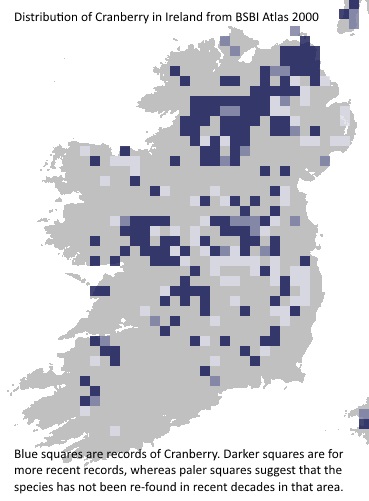Status
Native status
Native
Species Biology
Identification
- Plants grow to about 80 cm long but lie flat on the ground. They flower from June to August.
- Cranberry is a shrub which has very slender (0.5-0.7mm diameter) creeping stems on which small oval leaves (4-10mm) are spaced.
- The leaves are alternate and have very short petioles. They are dark green above and whitish underneath, with a revolute margin.
- Due to its low-growing, creeping nature, and small size, this species is easily over-looked.
- The flowers grow in groups of 3 on upright pedicels.
- Each pink/purple flower has a calyx with four lobes and a corolla with four backward pointing lobes so that the anthers and style protrude.
- The familiar Cranberry fruit is more or
less round, 6-8mm in diameter, and a red/pink colour.
Similar/related species:
Cowberry (Vacinnium vitis-idaea) is a rare close relative of Cranberry, but it has larger leaves 15-20mm long and downy young stems. Bog Rosemary’s (Andromeda polifolia) larger branches and longer leaves may also possibly be confused with those of Cranberry in the absences of a flower or fruits.
Habitat
Cranberry grows on wet acid sphagnum bogs. It is locally frequent in the centre and north of Ireland where raised bogs occur but much rarer elsewhere.
Life cycle
Perennial
Threats faced
These habitats are under threat of being lost due to drainage and turf cutting.
Ex-situ conservation
Not known
Distribution
World distribution(GBIF)
BSBI distribution map

Temporal change
Records submitted to Data Centre in 2024
The following map is interactive. If you would prefer to view it full screen then click here.
How can you help
If you have seen Cranberry or any of the
species in the Irish Species Project, please download the guidance document
for detailed instructions and the recording form where
you can tell us about the plants you’ve seen (also available at http://www.bsbi.org.uk/ireland.html).
You can also get in touch with your local
BSBI Vice County Recorder via Maria Long, BSBI Irish Officer (maria.long@bsbi.org) or contact her if you have any questions.
Further information
One of eight species chosen for the Irish Species Project, a two year recording effort by the Irish division of the Botanical Society of Britain and Ireland (BSBI). All eight species are thought to be declining, at least in parts of their range.
Full list of eight species included in the Irish Species Project:
Moonwort (Botrychium lunaria), Cyperus Sedge (Carex pseudocyperus), Autumn Gentian (Gentianella amarella), Toothwort (Lathraea squamaria), Grass-of-Parnassus (Parnassia palustris), Cowslip (Primula veris), Common Wintergreen (Pyrola minor), Cranberry (Vaccinium oxycoccos)
References
Publications
Parnell J. and Curtis T. (2012) Webb’s An Irish Flora. Cork: Cork
University Press 8th ed.
Poland J. and Clement E. (2009) The vegetative key to the British flora. Southampton:
John Poland in association with The Botanical Society of Britain and Ireland
Preston C.D., Pearman D.A. and Dines T.D.
(2002) New Atlas of the British and Irish
Flora: An Atlas of the Vascular Plants of Britain, Ireland, the Isle of Man and
the Channel Islands. Oxford: Oxford University Press
Rose F. and O’Reilly C. (2006) The Wild Flower Key: how to identify wild
flowers, trees and shrubs in Britain and Ireland. London: Frederick Warne rev.
ed.
Stace C. (2010) New Flora of the British Isles. Cambridge; New York: Cambridge
University Press 2010 3rd ed.
